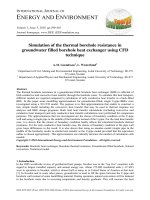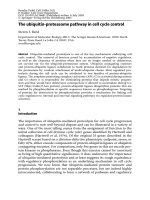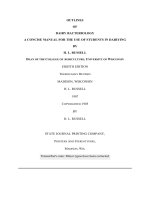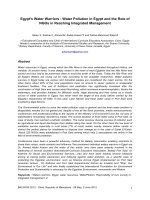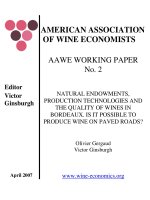prime numbers - the most mysterious figures in math
Bạn đang xem bản rút gọn của tài liệu. Xem và tải ngay bản đầy đủ của tài liệu tại đây (1.48 MB, 291 trang )
PRIME
NUMBERS
The Most Mysterious
Figures in Math
David Wells
John Wiley & Sons, Inc.
ffirs.qxd 3/22/05 12:12 PM Page i
ffirs.qxd 3/22/05 12:12 PM Page i
PRIME
NUMBERS
The Most Mysterious
Figures in Math
David Wells
John Wiley & Sons, Inc.
ffirs.qxd 3/22/05 12:12 PM Page i
Copyright © 2005 by David Wells. All rights reserved
Published by John Wiley & Sons, Inc., Hoboken, New Jersey
Published simultaneously in Canada
No part of this publication may be reproduced, stored in a retrieval system, or
transmitted in any form or by any means, electronic, mechanical, photocopying,
recording, scanning, or otherwise, except as permitted under Section 107 or 108 of
the 1976 United States Copyright Act, without either the prior written permission
of the Publisher, or authorization through payment of the appropriate per-copy fee
to the Copyright Clearance Center, 222 Rosewood Drive, Danvers, MA 01923, (978)
750-8400, fax (978) 646-8600, or on the web at www.copyright.com. Requests to
the Publisher for permission should be addressed to the Permissions Department,
John Wiley & Sons, Inc., 111 River Street, Hoboken, NJ 07030, (201) 748-6011, fax
(201) 748-6008, or online at />Limit of Liability/Disclaimer of Warranty: While the publisher and the author have
used their best efforts in preparing this book, they make no representations or
warranties with respect to the accuracy or completeness of the contents of this
book and specifically disclaim any implied warranties of merchantability or fitness
for a particular purpose. No warranty may be created or extended by sales
representatives or written sales materials. The advice and strategies contained
herein may not be suitable for your situation. You should consult with a
professional where appropriate. Neither the publisher nor the author shall be
liable for any loss of profit or any other commercial damages, including but not
limited to special, incidental, consequential, or other damages.
For general information about our other products and services, please contact our
Customer Care Department within the United States at (800) 762-2974, outside the
United States at (317) 572-3993 or fax (317) 572-4002.
Wiley also publishes its books in a variety of electronic formats. Some content that
appears in print may not be available in electronic books. For more information
about Wiley products, visit our web site at www.wiley.com.
Library of Congress Cataloging-in-Publication Data:
Wells, D. G. (David G.)
Prime numbers: the most mysterious figures in math / David Wells.
p. cm.
Includes bibliographical references and index.
ISBN-13 978-0-471-46234-7 (cloth)
ISBN-10 0-471-46234-9 (cloth)
1. Numbers, Prime. I. Title.
QA246.W35 2005
512.7'23—dc22 2004019974
Printed in the United States of America
10987654321
ffirs.qxd 3/22/05 12:12 PM Page ii
Contents
Acknowledgments xi
Author’s Note xiii
Introduction 1
Entries A to Z
abc conjecture 6
abundant number 7
AKS algorithm for primality testing 8
aliquot sequences (sociable chains) 9
almost-primes 11
amicable numbers 11
amicable curiosities 12
Andrica’s conjecture 13
arithmetic progressions, of primes 13
Aurifeuillian factorization 14
average prime 15
Bang’s theorem 16
Bateman’s conjecture 16
Beal’s conjecture, and prize 16
Benford’s law 17
Bernoulli numbers 19
Bernoulli number curiosities 20
Bertrand’s postulate 20
Bonse’s inequality 21
Brier numbers 21
Brocard’s conjecture 22
Brun’s constant 22
Buss’s function 23
Carmichael numbers 23
Catalan’s conjecture 24
Catalan’s Mersenne conjecture 25
Champernowne’s constant 26
ftoc.qxd 3/22/05 12:13 PM Page iii
champion numbers 26
Chinese remainder theorem 26
cicadas and prime periods 27
circle, prime 27
circular prime 28
Clay prizes, the 28
compositorial 29
concatenation of primes 29
conjectures 30
consecutive integer sequence 32
consecutive numbers 32
consecutive primes, sums of 32
Conway’s prime-producing machine 33
cousin primes 33
Cullen primes 34
Cunningham project 34
Cunningham chains 35
decimals, recurring (periodic) 36
the period of 1/13 36
cyclic numbers 37
Artin’s conjecture 38
the repunit connection 38
magic squares 39
deficient number 40
deletable and truncatable primes 40
Demlo numbers 40
descriptive primes 41
Dickson’s conjecture 41
digit properties 42
Diophantus (c. AD 200; d. 284) 42
Dirichlet’s theorem and primes in arithmetic series 44
primes in polynomials 45
distributed computing 45
divisibility tests 48
divisors (factors) 48
how many divisors? how big is d(n)? 49
record number of divisors 50
curiosities of d(n)50
divisors and congruences 51
the sum of divisors function 51
the size of σ (n)52
iv • Contents
ftoc.qxd 3/22/05 12:13 PM Page iv
a recursive formula 52
divisors and partitions 53
curiosities of σ (n)53
prime factors 54
divisor curiosities 54
economical numbers 55
Electronic Frontier Foundation 55
elliptic curve primality proving 56
emirp 57
Eratosthenes of Cyrene, the sieve of 58
Erdös, Paul (1913–1996) 59
his collaborators and Erdös numbers 61
errors 63
Euclid (c. 330–270 BC) 64
unique factorization 65
͙
2
ෆ
is irrational 65
Euclid and the infinity of primes 66
consecutive composite numbers 67
primes of the form 4n + 367
a recursive sequence 67
Euclid and the first perfect number 68
Euclidean algorithm 68
Euler, Leonhard (1707–1783) 69
Euler’s convenient numbers 70
the Basel problem 72
Euler’s constant 73
Euler and the reciprocals of the primes 73
Euler’s totient (phi) function 74
Carmichael’s totient function conjecture 75
curiosities of φ(n)77
Euler’s quadratic 77
the Lucky Numbers of Euler 78
factorial 80
factors of factorials 80
factorial primes 80
factorial sums 81
factorials, double, triple . . . 82
factorization, methods of 82
factors of particular forms 84
Fermat’s algorithm 85
Legendre’s method 86
Contents • v
ftoc.qxd 3/22/05 12:13 PM Page v
congruences and factorization 87
how difficult is it to factor large numbers? 87
quantum computation 88
Feit-Thompson conjecture 89
Fermat, Pierre de (1607–1665) 89
Fermat’s Little Theorem 91
Fermat quotient 92
Fermat and primes of the form x
2
+ y
2
92
Fermat’s conjecture, Fermat numbers, and Fermat primes 94
Fermat factorization, from F
5
to F
30
95
Generalized Fermat numbers 97
Fermat’s Last Theorem 97
the first case of Fermat’s Last Theorem 99
Wall-Sun-Sun primes 99
Fermat-Catalan equation and conjecture 100
Fibonacci numbers 101
divisibility properties 102
Fibonacci curiosities 103
Édouard Lucas and the Fibonacci numbers 104
Fibonacci composite sequences 105
formulae for primes 106
Fortunate numbers and Fortune’s conjecture 108
gaps between primes and composite runs 109
Gauss, Johann Carl Friedrich (1777–1855) 110
Gauss and the distribution of primes 111
Gaussian primes 112
Gauss’s circle problem 113
Gilbreath’s conjecture 113
GIMPS—Great Internet Mersenne Prime Search 115
Giuga’s conjecture 116
Giuga numbers 116
Goldbach’s conjecture 117
good primes 119
Grimm’s problem 119
Hardy, G. H. (1877–1947) 119
Hardy-Littlewood conjectures 121
heuristic reasoning 123
a heuristic argument by George Pólya 123
Hilbert’s 23 problems 124
home prime 125
hypothesis H 126
vi • Contents
ftoc.qxd 3/22/05 12:13 PM Page vi
illegal prime 126
inconsummate number 128
induction 128
jumping champion 131
k-tuples conjecture, prime 131
knots, prime and composite 132
Landau, Edmund (1877–1938) 134
left-truncatable prime 134
Legendre, A. M. (1752–1833) 134
Lehmer, Derrick Norman (1867–1938) 135
Lehmer, Derrick Henry (1905–1991) 135
Linnik’s constant 137
Liouville, Joseph (1809–1882) 137
Littlewood’s theorem 138
the prime numbers race 138
Lucas, Édouard (1842–1891) 139
the Lucas sequence 142
primality testing 144
Lucas’s game of calculation 145
the Lucas-Lehmer test 146
lucky numbers 147
the number of lucky numbers and primes 148
“random” primes 148
magic squares 149
Matijasevic and Hilbert’s 10th problem 150
Mersenne numbers and Mersenne primes 151
Mersenne numbers 152
hunting for Mersenne primes 152
the coming of electronic computers 153
Mersenne prime conjectures 155
the New Mersenne conjecture 156
how many Mersenne primes? 156
Eberhart’s conjecture 157
factors of Mersenne numbers 157
Lucas-Lehmer test for Mersenne primes 158
Mertens constant 159
Mertens theorem 159
Mills’ theorem 160
Wright’s theorem 161
mixed bag 161
multiplication, fast 162
Contents • vii
ftoc.qxd 3/22/05 12:13 PM Page vii
Niven numbers 163
odd numbers as p + 2a
2
164
Opperman’s conjecture 164
palindromic primes 164
pandigital primes 165
Pascal’s triangle and the binomial coefficients 165
Pascal’s triangle and Sierpinski’s gasket 167
Pascal triangle curiosities 167
patents on prime numbers 168
Pépin’s test for Fermat numbers 169
perfect numbers 170
odd perfect numbers 172
perfect, multiply 172
permutable primes 174
π, primes in the decimal expansion of 174
Pocklington’s theorem 175
Polignac’s conjectures 175
Polignac or obstinate numbers 175
powerful numbers 176
primality testing 177
probabilistic methods 179
prime number graph 180
prime number theorem and the prime counting function 181
history 181
elementary proof 182
record calculations 183
estimating p(n) 185
calculating p(n) 185
a curiosity 185
prime pretender 186
primitive prime factor 187
primitive roots 187
Artin’s conjecture 188
a curiosity 188
primorial 188
primorial primes 189
Proth’s theorem 189
pseudoperfect numbers 190
pseudoprimes 190
bases and pseudoprimes 192
viii • Contents
ftoc.qxd 3/22/05 12:13 PM Page viii
pseudoprimes, strong 192
public key encryption 193
pyramid, prime 194
Pythagorean triangles, prime 195
quadratic residues 195
residual curiosities 196
polynomial congruences 196
quadratic reciprocity, law of 197
Euler’s criterion 198
Ramanujan, Srinivasa (1887–1920) 198
highly composite numbers 199
randomness, of primes 200
Von Sternach and a prime random walk 202
record primes 203
some records 203
repunits, prime 204
Rhonda numbers 206
Riemann hypothesis 206
the Farey sequence and the Riemann hypothesis 209
the Riemann hypothesis and σ (n), the sum of divisors
function 210
squarefree and blue and red numbers 210
the Mertens conjecture 211
Riemann hypothesis curiosities 211
Riesel number 212
right-truncatable prime 212
RSA algorithm 212
Martin Gardner’s challenge 214
RSA Factoring Challenge, the New 215
Ruth-Aaron numbers 216
Scherk’s conjecture 217
semi-primes 217
sexy primes 218
Shank’s conjecture 218
Siamese primes 219
Sierpinski numbers 219
Sierpinski strings 219
Sierpinski’s quadratic 219
Sierpinski’s φ(n) conjecture 219
Sloane’s On-Line Encyclopedia of Integer Sequences 220
Contents • ix
ftoc.qxd 3/22/05 12:13 PM Page ix
Smith numbers 221
Smith brothers 222
smooth numbers 222
Sophie Germain primes 223
safe primes 224
squarefree numbers 224
Stern prime 225
strong law of small numbers 225
triangular numbers 228
trivia 228
twin primes 229
twin curiosities 230
Ulam spiral 232
unitary divisors 233
unitary perfect 234
untouchable numbers 235
weird numbers 235
Wieferich primes 235
Wilson’s theorem 236
twin primes 237
Wilson primes 237
Wolstenholme’s numbers, and theorems 238
more factors of Wolstenholme numbers 239
Woodall primes 240
zeta mysteries: the quantum connection 241
Appendix A: The First 500 Primes 245
Appendix B: Arithmetic Functions 249
Glossary 251
Bibliography 253
Index 265
x • Contents
ftoc.qxd 3/22/05 12:13 PM Page x
Acknowledgments
I am delighted to thank, once again, David Singmaster for his assis-
tance and the use of his library: on this occasion I can also note that
his thesis supervisor was D. H. Lehmer. I am happy to acknowledge
the following permissions:
The American Mathematical Society for permission to reproduce,
slightly modified, the illustration on page 133 of prime knots with
seven crossings or less from Pasolov and Sossinsky (1997), Knots,
links, braids and 3-manifolds, Translations of Mathematical Mono-
graphs 154:33, Figure 3.13.
Chris Caldwell for permission to reproduce, slightly modified, the
graph on page 156 showing the Mersenne primes, from his Prime
Pages Web site.
The graph on page 184 comparing various historical estimates of
the values of π(n) is in the public domain, but I am happy to note that
it is adapted from the diagram on page 224 of Beiler (1966), Recre-
ations in the Theory of Numbers, published by Dover Publications.
flast.qxd 3/22/05 12:12 PM Page xi
flast.qxd 3/22/05 12:12 PM Page xii
Author’s Note
Terms in bold, throughout the book, refer to entries in alphabetical
order, or to entries in the list of contents, and in the index.
Throughout this book, the word number will refer to a positive inte-
ger or whole number, unless stated otherwise.
Letters stand for integers unless otherwise indicated.
Notice the difference between the decimal point that is on the line,
as in
1
⁄8 = 0.125, and the dot indicating multiplication, above the line:
20 = 2 и 2 и 5
Divisor and factor: these are almost synonymous. Any differences are
purely conventional. As Hugh Williams puts it, if a divides b, then
“we call a a divisor (or factor) of b. Since 1 and a are always divisors
of a, we call these factors the trivial divisors (or factors) of a.”
(Williams 1998, 2)
On the other hand, we always talk about the prime factorization
of a number, because no word like divisorization exists! For this
reason, we also talk about finding the factors of a large number such
as 2
31
− 1.
Similarly, by convention, the divisor function d(n), which is the
number of divisors of n, is never called the factor function. And so on.
The meanings of φ (n), σ (n), and d(n) are explained in the glossary.
The natural logarithm of n, the log to base e, is written as log n. This
does not mean the usual logarithm to base 10, which would be writ-
ten log
10
n.
The expression 8 > 5 means that 8 is greater than 5. Similarly, 5 < 8
means that 5 is less than 8.
flast.qxd 3/22/05 12:12 PM Page xiii
The expression n ≥ 5 (5 ≤ n) means that n is greater than or equal to
5 (5 is less than or equal to n).
The expression 4 | 12 means that 4 divides 12 exactly.
The expression 4 |/ 13 means that 4 does not divide 13 exactly.
Finally, instead of saying, “When 30 is divided by 7 it leaves a
remainder 2,” it is much shorter and more convenient to write,
30 ϵ 2 (mod 7)
This is a congruence, and we say that “30 is congruent to 2, mod 7.”
The expression mod stands for modulus, because this is an example
of modular arithmetic. The idea was invented by that great mathe-
matician Gauss, and is more or less identical to the clock arithmetic
that many readers will have met in school.
In clock (or modular) arithmetic you count and add numbers as if
going around a clockface. If the clockface goes from 1 to 7 only, then
8 is the same as 1, 9 = 2, 10 = 3, and so on.
If, however, the clockface goes from 1 to 16 (for example), then
1 = 17, 2 = 18, and 3 и 9 = 11.
If you count in (say) 8s around the traditional clockface showing
12 hours, then your count will go: 8, 4, 12, 8, 4, 12, repeating end-
lessly and missing all the hours except 4, 8, and 12. If you count in
5s, however, it goes like this: 5, 10, 3, 8, 1, 6, 11, 4, 9, 2, 7, 12, 5, and
by the time you start to repeat you have visited every hour on the
clock. This is because 8 and 12 have a common factor 4, and but 5
and 12 have no common factor.
Mathematicians use the ϵ sign instead of =, the equal sign, to indi-
cate that they are using modular arithmetic. So instead of saying that
prime numbers are always of the form 6n + 1 or 6n − 1, because
6n + 2 and 6n + 4 are even and 6n + 3 is divisible by 3, we can write
6n ϵ Ϯ1 (mod 6).
Most statements made in this book have no reference. Either they are
well-known, or they can be found in several places in the literature.
Even if I do know where the claim was first made, a reference is not
necessarily given, because this is a popular book, not a work of
scholarship.
However, where a result appears to be due to a specific author or
collaboration of authors and is not widely known, I have given their
xiv • Author’s Note
flast.qxd 3/22/05 12:12 PM Page xiv
names, such as (Fung and Williams). If a date is added, as in (Fung
and Williams 1990), that means the reference is in the bibliography.
If this reference is found in a particular book, it is given as (Fung and
Williams: Guy).
The sequences with references to “Sloane” and an A number are
taken from Neil Sloane’s On-Line Encyclopedia of Integer Sequences,
at www.research.att.com/~njas/sequences. See also the entry in this
book for Sloane’s On-Line Encyclopedia of Integer Sequences, as well
as the “Some Prime Web Sites” section at the end of the bibliography.
The index is very full, but if you come across an expression such as
φ(n) and want to know what it means, the glossary starting on page
251 will help.
Author’s Note • xv
flast.qxd 3/22/05 12:12 PM Page xv
flast.qxd 3/22/05 12:12 PM Page xvi
Introduction
Prime numbers have always fascinated mathematicians. They
appear among the integers seemingly at random, and yet not
quite: there seems to be some order or pattern, just a little below
the surface, just a little out of reach.
—Underwood Dudley (1978)
Small children when they first go to school learn that there are two
things you can do to numbers: add them and multiply them. Addi-
tion sums are relatively easy, and addition has nice simple proper-
ties: 10 can be written as the sum of two numbers to make this pretty
pattern:
10 = 1 + 9 = 2 + 8 = 3 + 7 = 4 + 6 =
5 + 5 = 6 + 4 = 7 + 3 = 8 + 2 = 9 + 1
It is also easy to write even large numbers, like 34470251, as a sum:
34470251 = 34470194 + 57. The inverse of addition, subtraction, is
pretty simple also.
Multiplication is much trickier, and its inverse, division, is really
quite hard; the simple pattern disappears, and writing 34470251 as a
product is, well, fiendishly difficult. Suddenly, simple arithmetic has
turned into difficult mathematics!
The difficulty is easy to understand but hard to resolve. The fact is
that some numbers, the composite numbers, can be written as a
product of two other numbers, as we learn from our multiplication
tables. These numbers start with: 2 × 2 is 4, 2 × 3 is 6, and 2 × 4 is 8,
followed later by 3 × 3 is 9 and 6 × 7 is 42, and so on.
Other numbers cannot be written as a product, except of them-
selves and 1. For example, 5 = 5 × 1 = 1 × 5, but that’s all. These are
the mysterious prime numbers, whose sequence starts,
2, 3, 5, 7, 11, 13, 17, 19, 23, 29, 31,
37, 41, 43, 47, 53, 59, 61, 67, 71, . . .
01.qxd 3/22/05 12:05 PM Page 1
Notice that 1 is an exception: it is not counted as a prime number,
nor is it composite. This is because many properties of prime num-
bers are easier to state and have fewer exceptions if 1 is not prime.
(Zero also is neither prime nor composite.)
The prime numbers seem so irregular as to be random, although they
are in fact determinate. This mixture of almost-randomness and pat-
tern has enticed mathematicians for centuries, professional and ama-
teur alike, to make calculations, spot patterns, make conjectures, and
then (attempt) to prove them.
Sometimes, their conjectures have been false. So many conjectures
about primes are as elegant as they are simple, and the temptation to
believe them, to believe that you have discovered a pattern in the
primes, can be overwhelming—until you discover the counterexample
that destroys your idea. As Henri Poincaré wrote, “When a sudden
illumination invades the mathematicians’s mind, . . . it sometimes
happens . . . that it will not stand the test of verification . . . it is to be
observed almost always that this false idea, if it had been correct,
would have flattered our natural instincts for mathematical elegance.”
(Poincaré n.d.)
Sometimes a conjecture has only been proved many years later. The
most famous problem in mathematics today, by common consent, is
a conjecture, the Riemann hypothesis, which dates from a brilliant
paper published in 1859. Whoever finally proves it will become more
famous than Andrew Wiles, who was splashed across the front pages
when he finally proved Fermat’s Last Theorem in 1994.
This fertility of speculation has given a special role to the modern
electronic computer. In the good old bad old days, “computer” actu-
ally meant a person who computed, and a long and difficult task it
could be for the mathematician who was not a human calculator like
Euler or Gauss.
Today, computers can generate data faster than it can be read, and
can complete calculations in seconds or hours that would have taken
a human calculator years—and the computer makes no careless mis-
takes. (The programmer may err, of course!) Computers also put you
in touch with actual numbers, in a way that an abstract proof does
not. As John Milnor puts it:
If I can give an abstract proof of something, I’m reasonably happy. But if I
can get a concrete, computational proof and actually produce numbers I’m
much happier. I’m rather an addict at doing things on the computer I
2 • Introduction
01.qxd 3/22/05 12:05 PM Page 2
have a visual way of thinking, and I’m happy if I can see a picture of what
I’m working with. (Bailey and Borwein 2000)
It has even been seriously argued that mathematics is becoming
more of an experimental science as a result of the computer, in
which the role of proof is devalued. That is nonsense: it is only by
penetrating below the surface glitter that mathematicians gain the
deepest understanding. Why did Gauss publish six proofs of the law
of quadratic reciprocity (and leave a seventh among his papers)?
Because each proof illuminated the phenomenon from a different
angle and deepened his understanding.
Computers have had two other effects. The personal computer has
encouraged thousands of amateurs to get stuck in and to explore the
prime numbers. The result is a mass of material varying from the
amusing but trivial to the novel, serious, and important.
The second effect is that very complex calculations needed to
prove that a large number is prime, or to find its factors, have sud-
denly become within reach. In 1876 Édouard Lucas proved that
2
127
− 1 is prime. It remained the largest known prime of that form
until 1951. Today, a prime of this size can be proved prime in a few
seconds, though the problem of factorization remains intractable for
large numbers, so public key encryption and methods such as the
RSA algorithm have recently made prime numbers vitally important
to business (and the military).
Despite the thousands of mathematicians working on properties of the
prime numbers, numerous conjectures remain unresolved. Computers
are wonderful at creating data, and not bad at finding counterexam-
ples, but they prove nothing. Many problems and conjectures about
prime numbers will only be eventually solved through deeper and
deeper insight, and for the time being seem to be beyond our under-
standing. As Gauss put it, “It is characteristic of higher arithmetic that
many of its most beautiful theorems can be discovered by induction
with the greatest of ease but have proofs that lie anywhere but near at
hand and are often found only after many fruitless investigations with
the aid of deep analysis and lucky combinations.” See our entry on zeta
mysteries: the quantum connection! Gauss added, referring to his own
methods of working as well as those of Fermat and Euler and others:
[I]t often happens that many theorems, whose proof for years was sought
in vain, are later proved in many different ways. As soon as a new result is
Introduction • 3
01.qxd 3/22/05 12:05 PM Page 3
discovered by induction, one must consider as the first requirement the
finding of a proof by any possible means [emphasis added]. But after such
good fortune, one must not in higher arithmetic consider the investigation
closed or view the search for other proofs as a superfluous luxury. For
sometimes one does not at first come upon the most beautiful and simplest
proof, and then it is just the insight into the wonderful concatenation of
truth in higher arithmetic that is the chief attraction for study and often
leads to the discovery of new truths. For these reasons the finding of new
proofs for known truths is often at least as important as the discovery itself.
(Gauss 1817)
The study of the primes brings in every style and every level of
mathematical thinking, from the simplest pattern spotting (often mis-
leading, as we have noted) to the use of statistics and advanced
counting techniques, to scientific investigation and experiment, all
the way to the most abstract concepts and most subtle proofs that
depend on the unparalleled insight and intuitive perceptions of the
greatest mathematicians. Prime numbers offer a wonderful field for
exploration by amateurs and professionals alike.
This is not a treatise or an historical account, though it contains
many facts, historical and otherwise. Rather, it is an introduction to
the fascination and beauty of the prime numbers. Here is an exam-
ple that I have occasionally used to, successfully, persuade nonbe-
lievers with no mathematical background that mathematics can
indeed be delightful. First write down the square numbers, 1 и 1 = 1,
2 и 2 = 4, 3 и 3 = 9, and so on. (Notice that to avoid using the × for
multiplication, because x is also used in algebra, we use a dot above
the text baseline.)
149162536496481100
This sequence is especially simple and regular. Indeed, we don’t
even need to multiply any numbers to get it. We could just as well
have started with 1 and added the odd numbers. 1 + 3 = 4; 4 + 5 = 9;
9 + 7 = 16, and so on.
Now write down the prime numbers, the numbers with no factors
except themselves and 1:
2357111317192329
No such simplicity here! The jumps from one number to the next
vary irregularly from 1 to 6 (and would eventually become much
larger). Yet there is a concealed pattern connecting these two
sequences. To see it, strike out 2, which is the only even prime, and
4 • Introduction
01.qxd 3/22/05 12:05 PM Page 4
all the primes that are one less than a multiple of 4; so we delete 3,
7, 11, 19, and 23 . . . The sequence of remaining primes goes,
5131729374153576173
And the connection? Every one of these primes is the sum of two
squares, of two of the numbers in the first sequence, in a unique way:
5 = 1 + 4, 13 = 4 + 9, 17 = 1 + 16, 29 = 4 + 25, 37 = 1 + 36
and so on. This extraordinary fact is related to Pythagoras’s theorem
about the sides of a right-angled triangle, and was known to Dio-
phantus in the third century. It was explored further by Fermat, and
then by Euler and Gauss and a host of other great mathematicians.
We might justly say that it has been the mental springboard and the
mysterious origin of a large portion of the theory of numbers—and
yet the basic facts of the case can be explained to a school pupil.
There lies the fascination of the prime numbers. They combine the
maximum of simplicity with the maximum of depth and mystery.
On a plaque attached to the NASA deep space probe we are de-
scribed in symbols for the benefit of any aliens who might meet the
spacecraft as “bilaterally symmetrical, sexually differentiated bipeds
located on one of the outer spirals of the Milky Way, capable of rec-
ognizing the prime numbers and moved by one extraordinary qual-
ity that lasts longer than all our other urges—curiosity.”
I hope that you will discover (or be reminded of ) some of the fasci-
nation of the primes in this book. If you are hooked, no doubt you
will want to look at other books—there is a selection of recom-
mended books marked in the bibliography with an asterisk—and
you will also find a vast amount of material on the Internet: some of
the best sites are listed at the “Some Prime Web Sites” section at the
end of the bibliography. To help you with your own research,
Appendix A is a list of the first 500 primes, and Appendix B lists the
first 80 values of the most common arithmetic functions.
Note: As this book went to press, the record for the largest known
prime number was broken by Dr. Martin Nowak, a German eye spe-
cialist who is a member of the worldwide GIMPS (Great Internet
Mersenne Prime Search) project, after fifty days of searching on his
2.4GHz Pentium 4 personal computer. His record prime is 2
25,964,951
− 1
and has 7,816,230 digits.
Introduction • 5
01.qxd 3/22/05 12:05 PM Page 5
abc conjecture
The abc conjecture was first proposed by Joseph Oesterlé and David
Masser in 1985. It concerns the product of all the distinct prime factors
of n, sometimes called the radical of n and written r (n). If n is square-
free (not divisible by any perfect square), then r (n) = n. On the other
hand, for a number such as 60 = 2
2
и 3 и 5, r (60) = 2 и 3 и 5 = 30.
r (n) is smallest when n is a power of a prime: then r ( p
q
) = p. So
r (8) = r (32) = r (256) = 2, and r (6561) = r (3
8
) = 3.
The more duplicated factors n has, the larger n will be compared to
r (n). For example, if n = 9972 = 2
2
и 3
2
и 277, then r (9972) = 1662,
and r (n) =
1
⁄4n.
The abc conjecture says, roughly, that if a and b are two numbers
with no common factor, and sum c, then the number abc cannot be
very composite. More precisely, David Masser proved that the ratio
r (abc)/c can be as small as you like. Less than
1
⁄100? Yes! Less than
0.00000001? Yes! And so on.
However—and this is Masser’s claim and the abc conjecture—this
is only just possible. If we calculate r (abc)
n
/c instead, where n is any
number greater than 1, then we can’t make r (abc)/c as small as we
like, and this is true even if n is only slightly greater than 1. So even
if n is as small as 1.00001, r (abc)
n
/c has a lower limit that isn’t zero.
Why is this conjecture about numbers that are not squarefree so
important? Because, incredibly, so many important theorems could
be proved quite easily, if it were true. Here are just five of the many
consequences of the abc conjecture being true:
• Fermat’s Last Theorem could be proved very easily. The proof
by Andrew Wiles is extremely long and complex.
• There are infinitely many Wieferich primes.
• There is only a finite number of sets of three consecutive pow-
erful numbers.
• There is only a finite number of solutions satisfying Brocard’s
equation, n! + 1 = m
2
.
• All the polynomials (x
n
− 1)/(x − 1) have an infinity of square-
free values. (Browkin 2000, 10)
6 • abc conjecture
01.qxd 3/22/05 12:05 PM Page 6

